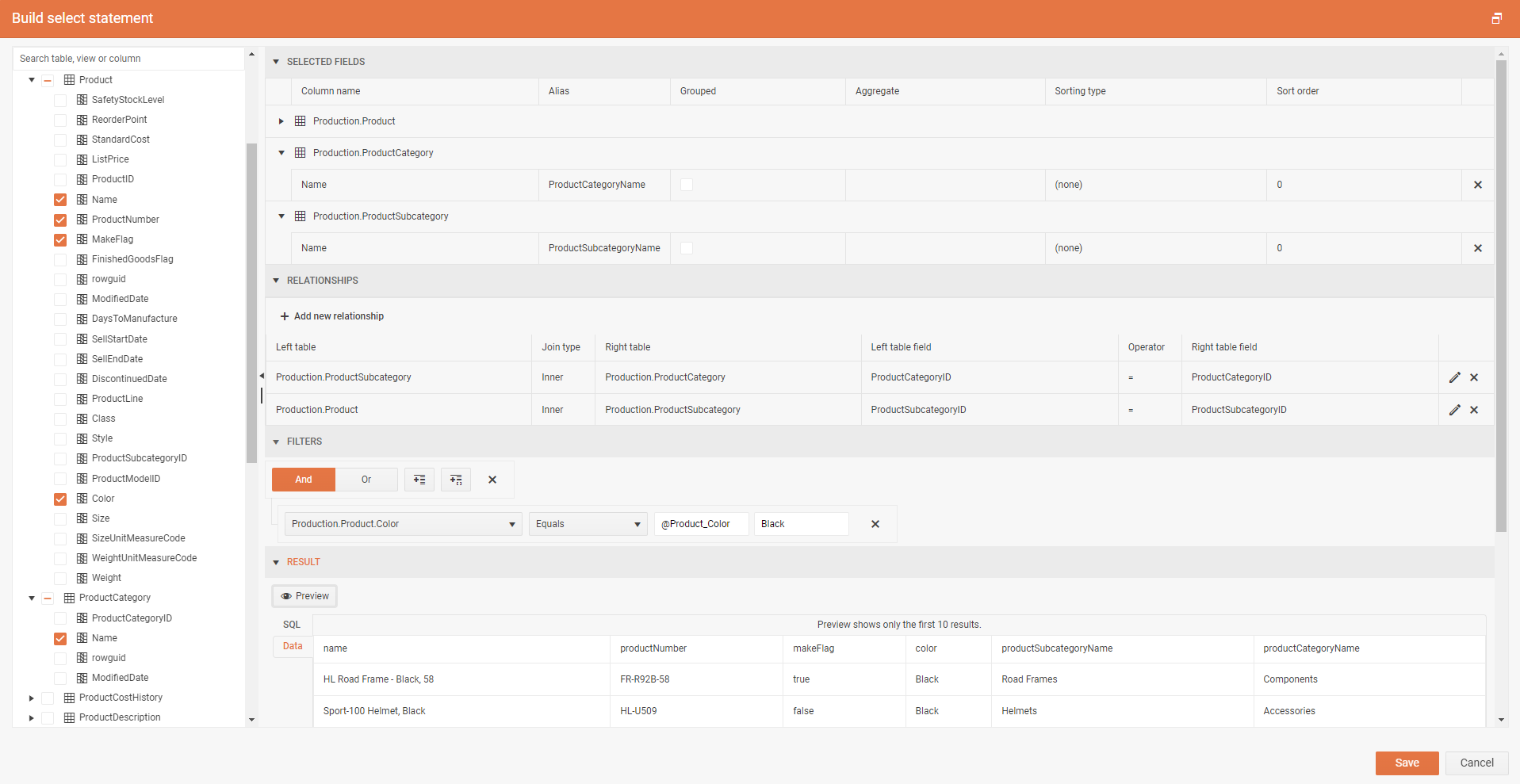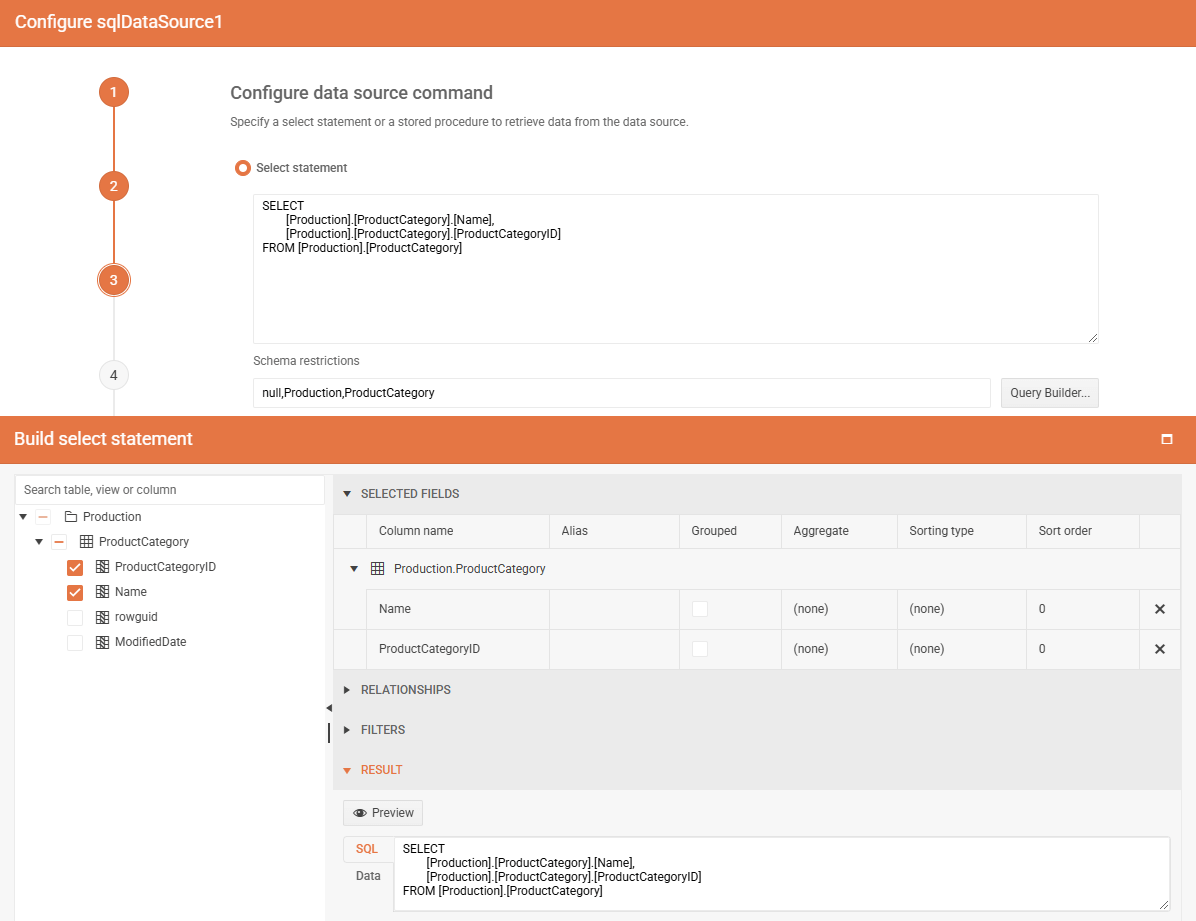Web Report Designer Query Builder
The Web Report Designer provides both a graphical and a text-based query builder to help you create queries to retrieve data from a relational database for a SqlDataSource component. The Query Builder supports any ADO.NET/ODB/OLEDB data provider with a working implementation of GetSchema with COLUMN collection support.
The following figure shows the graphical query builder.

Use the graphical query builder to explore the database tables and views, interactively build SQL SELECT statements, and view the result. The select statement specifies the database tables, views and columns from which to retrieve data for an SqlDataSource component. If you choose multiple related tables, you need to specify the relationship between each set of two tables.
Schema Restrictions
As of 2025 Q1, the Query Builder of the Web Report Designer accepts a new property called SchemaRestrictions. The value of this property is a comma-separated list of schema restrictions that will be used by the chosen data provider to query a subset of data from the database schema. This allows report creators to load only the necessary schema information and benefit from faster load times.
Behind the scenes, the Reporting engine calls the ADO.NET GetSchema method on the columns collection and passes the schema restrictions specified by the user. The exact number and order of schema restriction arguments can vary depending on the selected data provider. For example, provided we have a connection to the Microsoft SQL Server AdventureWorks sample database, we can pass the following string to the schema restrictions field to instruct the Query Builder to load the schema of the ProductCategory table only.
null,Production,ProductCategory
Schema restrictions are case-sensitive and empty arguments are respected. If you need to provide a null value for a specific argument, you can use the
nullkeyword as demonstrated in the example above. The schema restrictions work only with .NET 8+.

Query Builder Panes
The following sections describe the function of each pane.
- Database View Displays a hierarchical view of tables and views that are organized by database schema.
- Selected Fields Displays the list of database field names from the selected items in the Database View pane.
- Relationships Displays a list of relationships between the selected tables.
- Filters Displays a list of filter criteria for tables or views.
- Result Displays sample data for the automatically generated query.
Database View Pane
The Database View pane is positioned on the left-hand side of the form. It displays the metadata for database objects that you have permission to view. The permission is determined by the data source connection and credentials. The hierarchical view displays database objects organized by database schema. Expand the node for each schema to view tables and views. Expand a table or view to display its columns.
The columns checked in this pane are automatically transferred to the Selected Fields pane. If a table is checked, all of its columns will be transferred to the Selected Fields pane. The relationship editor opens automatically when more than one table is checked.
Selected Fields Pane
The Selected Fields pane displays the selected columns to include in the query. The fields displayed in this pane become the field collection for the report data item. These fields represent the data you can display in tables, graphs, and other report items when you view a report.
The following columns are displayed:
- Column name Displays the selected field names grouped by the table or view they belong to.
- Alias The alias to use for the field. The alias will be automatically generated if the last added field name is already in use. Additionally, field aliases can be changed or added manually.
- Grouped Displays a checkbox that indicates whether the field should be used in a grouping statement.
-
Aggregate Displays the aggregate to be applied to the field (a grouped field cannot have an aggregate). The available options are
Count,Max,Min,Average, andSum. By default, theSumaggregate will be applied to all fields that are not part of the query's grouping statement when theGroupedcheckbox of a field is ticked. -
Sorting type Displays the sorting type to be applied to the field. The available options are
(none),Ascending, andDescending. By default, the(none)option is selected, indicating that the selected statement will not be sorted based on the current field. - Sort order Displays the order in which the field sortings should be applied.
- Remove Contains a button to remove the current field from the select query. Removing the field requires confirmation.
Relationships Pane
The Relationships pane displays the SQL JOIN statements that need to be created for the selected tables.
The following option is available:
- Add new relationship Opens the relationship editor used to define relationships between tables or views. Each relationship generates a join clause in the query. When using multiple relationships in a query, one of the tables in each relationship, except the first one, must be referenced in preceding relationships.
The following columns are available:
- Left table Displays the name of the first table that is part of the join relationship.
-
Join type Displays the type of SQL join statement that is used in the automatically generated query. The available join types are
Inner,Left,Right,Outer, andUnrelated. - Right table Displays the name of the second table that is part of the join relationship.
- Left table field Indicates which field from the left table should be used in the join statement.
- Operator Displays the operator used on the left and right fields from the joined tables.
- Right table field Indicates which field from the right table should be used in the join statement.
- Edit/Remove Contains buttons to edit or remove the current relationship.
Filters Pane
The Filters pane displays the criteria used to limit the number of data rows that are retrieved at runtime. Criteria specified in this pane are used to generate an SQL WHERE clause.
The following options are available:
-
Logical operator Choose the logical operator used between the filter expressions in the current group. The available options are
AndandOr. - Add Expression Add a new filter expression to the current group.
- Add Group Add a new filter group that can have a different logical operator. Filter groups can be defined hierarchically.
- Close Remove the current filter group and all of its child filter expressions.
The following columns are displayed:
- Field Name Displays the name of the field to apply the criteria.
- Operator The operator to use in the filter expression.
- Value/Parameter name The value or parameter name to add to the query.
- Preview value The value to use for the Result pane.
- Delete Remove the current filter expression from the expression group.
Result Pane
The Result pane displays the automatically generated query that is specified by selections in the other panes. It can also preview the data returned after executing the query. The columns in the result set are the fields that you specify in the Selected Fields pane.
The data is not saved in the report definition. The actual data in the report is retrieved when the report is processed.
The following options are available:
- Preview button Preview the automatically generated query or the data returned by it based on the selections in the other panes.
- SQL/Data switch Choose between previewing the automatically generated SQL query or the data returned by it.
Query Builder State
After clicking Save, the SqlDataSource Wizard Select Statement will be replaced with the currently generated SQL query.
The Query Builder keeps the current setup state. However, if you modify the SQL query outside it and then use the Query Builder, it will override the manual SQL query modifications.
The functionalities of the Web Report Designer Query Builder and Standalone Report Designer Query Builder are not identical. Thus, if a report that has been edited by the Query Builder of the Web Report Designer is opened in the Query Builder of the Standalone Report Designer, an error message about an inconsistent query state may be shown.